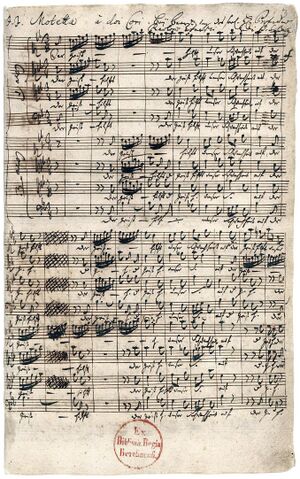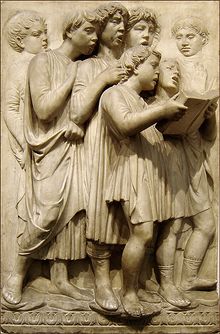موتت

في الموسيقى الكلاسيكية الغربية، موتت أو موتيت (motet) هو صنف من التآليف الغنائية الغربية، يؤدى عن طريق صوت واحد أو مجموعة من الأصوات، قد يتم في بعض الحالات مصاحبة الأصوات ببعض الآلات الموسيقية.
ظهر الموتيت في القرن الثامن الميلادي، وكان الهدف منه تطوير الغناء الأحادي الصوت المصاحب للطقوس الدينية الكنسية. رغم أنه في الأصل ذو طبيعة دينية إلا أن بعض التآليف قد تشذ عن هذه القاعدة.
أصل الاسم
في مطلع القرن العشرين، ساد اعتقاد عام أن الاسم جاء من الكلمة اللاتينية movere (to move), though a derivation from the French mot ("word", or "phrase") had also been suggested. The Medieval Latin for "motet" is motectum, and the Italian mottetto was also used.[1] If the word is from Latin, the name describes the movement of the different voices against one another. Today, however, the French etymology is favoured by reference books, as the word "motet" in 13th-century French had the sense of "little word".[2][3][4][5] In fact, the troped clausulas that were the forerunner of the motet were originally called motelli (from the French mot, "word"), soon replaced by the term moteti.[6]
مؤلفو موتتات النهضة
| جزء من سلسلة عن |
| موسيقى عصر النهضة |
|---|
| استعراض |
|
|
|
|
كان الموتت أحد الصيغ البارزة في موسيقى النهضة. المؤلفون البارزون الآخرون لموتت النهضة ضموا:
- ألكسندر أگريكولا Alexander Agricola
- Gilles Binchois
- Antoine Busnois
- وليام بيرد William Byrd
- Johannes Vodnianus Campanus
- Loyset Compère
- Josquin des Prez
- John Dunstaple
- أنطوان ده فيڤان Antoine de Févin
- Francisco Guerrero
- Nicolas Gombert
- Heinrich Isaac
- Pierre de La Rue
- Orlando di Lasso
- Cristóbal de Morales
- Jean Mouton
- Jacob Obrecht
- Johannes Ockeghem
- مارتن پيرسون
- Giovanni Pierluigi da Palestrina
- Thomas Tallis
- جون تاڤرنر John Taverner
- Robert Carver
- توماس لويز ده ڤيكتوريا
موتت الباروك
الاسم "موتت" حوفظ عليه في موسيقى الباروك, especially in France, where the word was applied to two distinct, and very different, genres: petits motets, sacred choral or chamber compositions whose only accompaniment was a basso continuo; and grands motets, which included massed choirs and instruments up to and including a full orchestra. جان-باتيست لولي was an important composer of this sort of motet. Lully's motets often included parts for soloists as well as choirs; they were longer, including multiple movements in which different soloist, choral, or instrumental forces were employed. Lully's motets also continued the Renaissance tradition of semi-secular Latin motets in works such as Plaude Laetare Gallia, written للاحتفال بتعميد ابن الملك لويس الرابع عشر؛ كتب نصها پيير پران ومطلعها:
- Plaude laetare Gallia
- Rore caelesti rigantur lilia,
- Sacro Delphinus fonte lavatur
- Et christianus Christo dicatur.
- (Rejoice and sing, France: the lily is bathed with heavenly dew. The Dauphin is bathed in the sacred font, and the Christian is dedicated to Christ.)
في ألمانيا، too, pieces called motets were written in the new musical languages of the Baroque. هاينريش شوتس wrote many motets in a series of publications called Symphoniae sacrae, some in Latin and some in German.
موتتات باخ
كتب يوهان سباستيان باخ أعمالاً أسماها موتت، relatively long pieces in German on sacred themes for choir and basso continuo, with instruments playing colla parte, several of them composed for funerals. Six motets certainly composed by Bach are:
- BWV 225 Singet dem Herrn ein neues Lied (1726)
- BWV 226 Der Geist hilft unser Schwachheit auf (1729)
- BWV 227 Jesu, meine Freude (?)
- BWV 228 Fürchte dich nicht (?)
- BWV 229 Komm, Jesu, komm! (1730?)
- BWV 230 Lobet den Herrn, alle Heiden (?)
الهامش
- ^
 William Henry Grattan Flood (1913). [[wikisource:Catholic Encyclopedia (1913)/Motet "|Motet]"]. Catholic Encyclopedia. New York: Robert Appleton Company.
William Henry Grattan Flood (1913). [[wikisource:Catholic Encyclopedia (1913)/Motet "|Motet]"]. Catholic Encyclopedia. New York: Robert Appleton Company. {{cite encyclopedia}}: Check|url=value (help) - ^ قالب:OED entry "Motet".
- ^ Willi Apel, “Motet”, Harvard Dictionary of Music, second edition (Cambridge, MA: Harvard University Press, 1969). ISBN 0674375017.
- ^ James Peter Burkholder, Donald Jay Grout, and Claude V. Palisca A History of Western Music, eighth edition (New York: W. W. Norton & Company, 2010): 102. ISBN 978-0-393-93125-9.
- ^ Jerome Roche and Elizabeth Roche. "Motet". The Oxford Companion to Music, edited by Alison Latham (New York: Oxford University Press, 2001). ISBN 978-0-19-866212-9.
- ^ خطأ استشهاد: وسم
<ref>غير صحيح؛ لا نص تم توفيره للمراجع المسماةNewGrove
